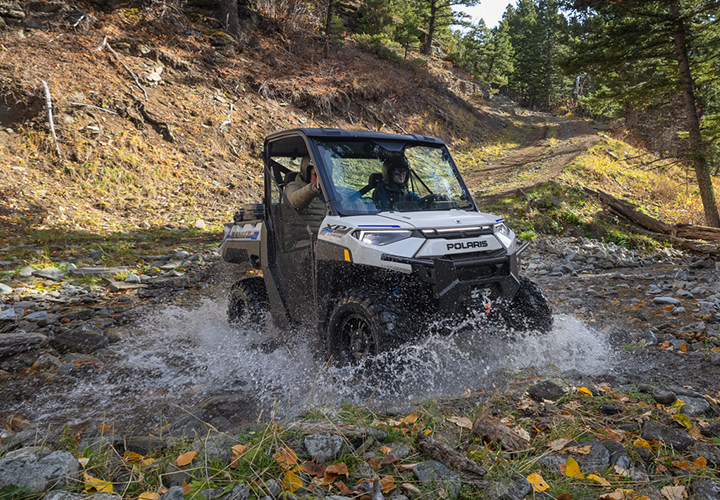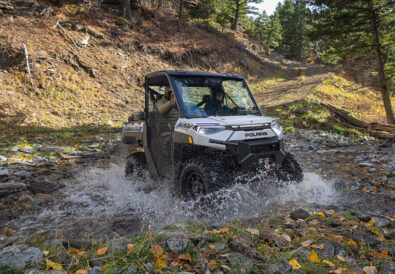ATV Adventures: Is there room in the OHV world for electronic UTVs?

Pictures provided by Polaris Industries
The Polaris XP Kinetic on the trail.Is the world ready for an all-electric UTV (e-UTV)? The complex answer is yes and no. While the technology is still developing and widespread viability has a long way to go for some large-scale applications, many see the clear potential and are willing to adopt smaller electric machines.
e-UTV benefits
To begin with, e-UTVs have an excellent list of benefits:
Silent operation – improves communication between riders, makes wildlife easier to observe, and enhances the outdoor experience by reducing noise pollution.
Maximum torque – not only is the power delivered instantaneously and silently, but the motor’s torque can also be controlled with precision. For example, when navigating steep paths or rocky terrain, the driver can adjust the power output to suit the situation. These UTVs offer easy torque at any speed with no need to shift.
Regenerative braking – enables the vehicle to transform kinetic energy from braking into electrical energy to power the battery, extending the range. Steep grades can be traversed by just applying and releasing the accelerator pedal. Regenerative braking provides a sudden power drop, eliminating the need for lockers or lower gears.
Low maintenance fees – with significantly fewer moving parts than a combustion engine, there is less maintenance required on an e-UTV. With no need for fuel, oil changes, and fewer wear components, there are substantial long-term savings and less downtime.
e-UTV challenges
On the other side of the coin, some hurdles are squelching sales:
Range anxiety – this is the key concern in the recreational market. The Polaris XP Kinetic comes in two models – Premium and Ultimate. The Premium model has an estimated range of 45 miles, while the Ultimate can go up to 80 miles on a charge. Those ranges were determined on a machine traveling at 25 mph with 250 lbs. of cargo. If you put the pedal to the metal and run all the accessories, all bets are off.
It takes 10 hours to charge the Premium on 120V and 20 hours to charge the Ultimate. Plugging into a 240V system reduces those times to five on the Premium and five on the Ultimate. Polaris recommends keeping it plugged in when not in use. The greatest fear is being far from home when you run out of juice.
Cost – the MSRP for the Polaris Premium model is about $30,000, while the Ultimate goes for $37,500. Once over that hurdle, the low maintenance will help reduce that cost.
e-UTVs are on the market
Major manufacturers are producing e-UTVs, including Polaris, Can-Am, and Arctic Cat. KTM offers an e-dirt bike. Let’s take a closer look at the Polaris electronic offering – the Polaris XP Kinetic. It comes with a 110 hp electric motor, 140 lb. ft torque, and increased towing capacity.
Where do e-UTVs fit?
To better understand where they fit, we need to look at the different market segments. Let’s take a look at these sectors:
Construction – I have seen many EVs in use on construction sites, particularly golf carts and small maintenance vehicles. Contractors appreciate the benefits, but still face upfront costs, battery range, and operator training.
Mining – This sector has embraced e-technology. While big 240-ton haul trucks have been powered by diesel-electric motors, large 1.4-megawatt battery packs are replacing those old power plants. I can’t imagine one of those big OHVs on any trail I have ridden.
EVs play an important role in underground mining because they require clean air to operate. They have solved the range anxiety problem. When a battery runs low, the driver goes into a service bay and swaps the used battery for a new one – no downtime.
Farming – Farmers’ opinions on EVs are mixed. They are more receptive to using them for light-duty tasks, but they rely on conventional tractors for heavy-duty tasks. Putting an EV on a job requiring a lot of power will require recharging sooner and more often.
Railroads – This segment is beginning to use e-UTVs primarily for maintenance, inspections, and crew transport. Railroads are also testing hybrid (diesel-electric or battery-diesel) vehicles for heavy-duty track work.
Not ready for prime time in the recreational world
While e-UTVs have a promising future, the concept is still developing. In the recreational world, the e-UTV is not ready for prime time. The power required to negotiate backcountry terrain would significantly reduce battery life between charges. Polaris is offering the two Kinetic models, but only the 2024 models are available–no ’25 or ’26 models are offered.
When you go, take plenty of water, keep the rubber side down, and if you choose to take an e-UTV, stay close to home, or carry a gas-powered generator.
Lynn R. Blamires can be reached at quadmanone@gmail.com.



